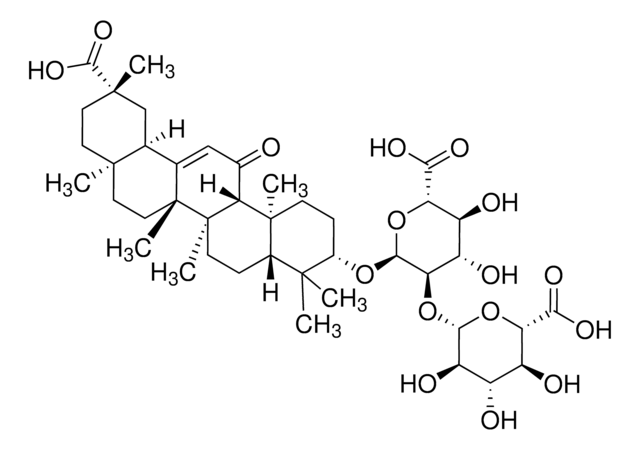M7755
Monellin from Dioscoreophyllum cumminsii (serendipity berry)
Zaloguj sięWyświetlanie cen organizacyjnych i kontraktowych
About This Item
Polecane produkty
Poziom jakości
Szukasz podobnych produktów? Odwiedź Przewodnik dotyczący porównywania produktów
Opis ogólny
Monellin is considered a sweet protein and consists of two subunits, chain A and chain B. It is used as a non-carbohydrate sweetener and is beneficial for diabetic patients.
Zastosowanie
Monellin from Dioscoreophyllum cumminsii (serendipity berry) has been used in biophysical studies.
Inne uwagi
An intensely sweet protein.
Jakość
Partially purified.
Ta strona może zawierać tekst przetłumaczony maszynowo.
Kod klasy składowania
11 - Combustible Solids
Klasa zagrożenia wodnego (WGK)
WGK 3
Temperatura zapłonu (°F)
Not applicable
Temperatura zapłonu (°C)
Not applicable
Środki ochrony indywidualnej
Eyeshields, Gloves, type N95 (US)
Wybierz jedną z najnowszych wersji:
Masz już ten produkt?
Dokumenty związane z niedawno zakupionymi produktami zostały zamieszczone w Bibliotece dokumentów.
Wei-Feng Xue et al.
Proteins, 57(3), 586-595 (2004-09-24)
Accurate and precise determinations of thermodynamic parameters of binding are important steps toward understanding many biological mechanisms. Here, a multi-method approach to binding analysis is applied and a detailed error analysis is introduced. Using this approach, the binding thermodynamics and
Nilesh Aghera et al.
Protein expression and purification, 76(2), 248-253 (2010-11-10)
Monellin is an intensely sweet-tasting protein present in the berry of Dioscoreophyllum cumminsii. Naturally occurring monellin (double chain monellin) is a heterodimer of two subunits commonly referred to as chain A and chain B. Monellin is a good model system
Wei-Feng Xue et al.
Biochimica et biophysica acta, 1794(3), 410-420 (2008-12-23)
A small number of proteins have the unusual property of tasting intensely sweet. Despite many studies aimed at identifying their sweet taste determinants, the molecular basis of protein sweetness is not fully understood. Recent mutational studies of monellin have implicated
Fushan Liu et al.
Journal of experimental botany, 63(3), 1167-1183 (2011-11-29)
Amylose extender (ae(-)) starches characteristically have modified starch granule morphology resulting from amylopectin with reduced branch frequency and longer glucan chains in clusters, caused by the loss of activity of the major starch branching enzyme (SBE), which in maize endosperm
Fushan Liu et al.
Journal of experimental botany, 60(15), 4423-4440 (2009-10-07)
The amylose extender (ae(-)) mutant of maize lacks starch branching enzyme IIb (SBEIIb) activity, resulting in amylopectin with reduced branch point frequency, and longer glucan chains. Recent studies indicate isozymes of soluble starch synthases form high molecular weight complexes with
Nasz zespół naukowców ma doświadczenie we wszystkich obszarach badań, w tym w naukach przyrodniczych, materiałoznawstwie, syntezie chemicznej, chromatografii, analityce i wielu innych dziedzinach.
Skontaktuj się z zespołem ds. pomocy technicznej





